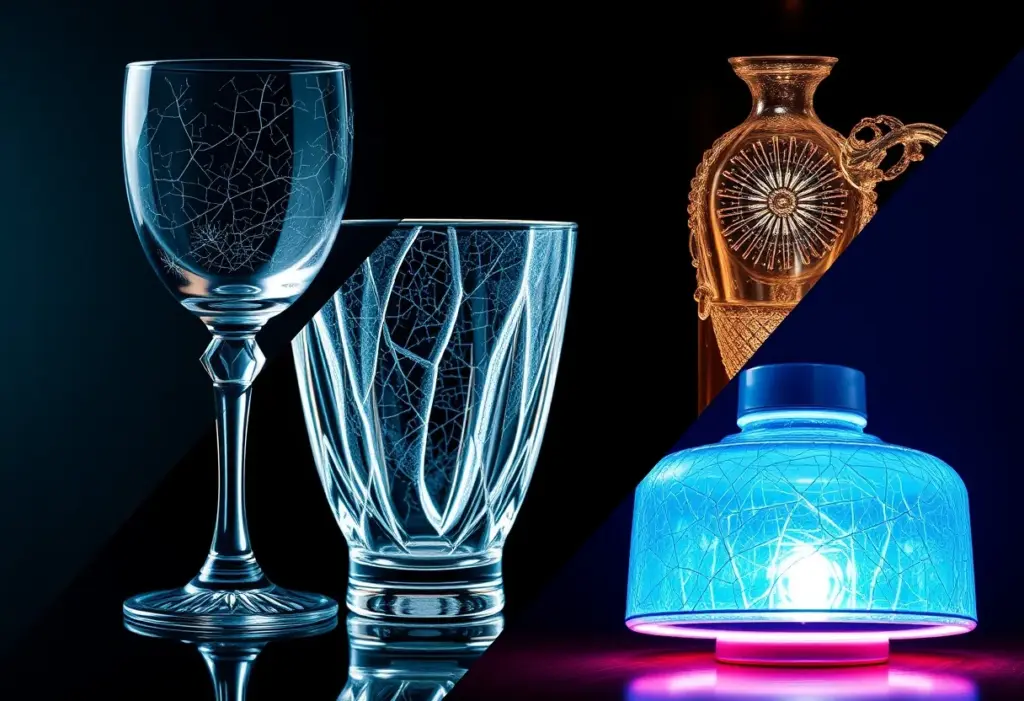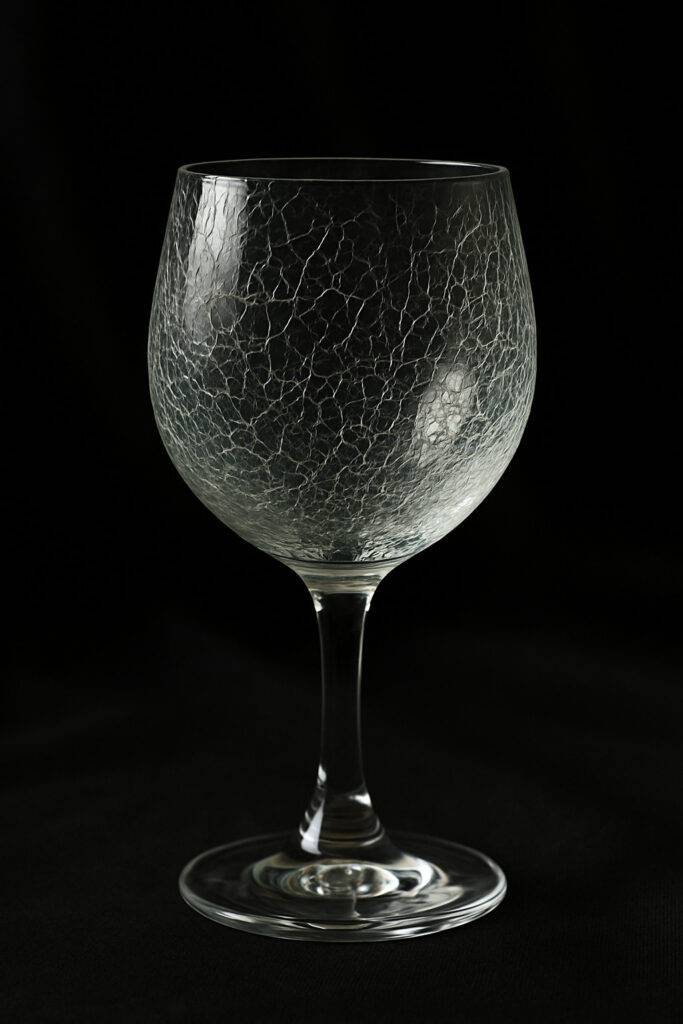> Blogs > Origin of Ice Crack Craftsmanship: From Porcelain to Glass
Origin of Ice Crack Craftsmanship: From Porcelain to Glass
Core keywords: origin of ice crack craftsmanship, crackle glass history, ice crack glaze
The origin of ice crack craftsmanship can be traced through centuries of artistic experimentation, giving glass and porcelain objects their distinctive network of fine cracks. At first glance, these patterns resemble fractures, yet the pieces remain solid and usable. This paradox—cracked on the surface but strong at the core—is what makes the style so recognizable.
You can find ice crack textures in many places today: crystal goblets, vases, architectural glass bricks, even modern lighting. Each object carries unique lines that never repeat, like a fingerprint frozen into the material. This unpredictability often raises questions for viewers: How are these cracks created? Were they accidents, or the result of a deliberate craft?

To answer these questions, we must look back to the origin of ice crack craftsmanship—tracing its journey from the kilns of ancient porcelain makers to the furnaces of modern glass artisans.
The Origin of Ice Crack Craftsmanship in Ceramics
Song Dynasty Innovation
The earliest documented origin of ice crack craftsmanship lies in Song Dynasty China (960–1279 CE), when imperial kilns such as Ru ware and Guan ware produced ceramics with what appeared to be accidental surface fractures. These fissures were not structural breaks but fine cracks within the glaze layer, caused by the mismatch of thermal expansion between glaze and clay body. As the vessels cooled, the tension created a web of intricate lines, later admired as ice crack glaze.

What began as a technical imperfection soon became a hallmark of aesthetic sophistication. Rather than discarding these pieces, scholars and aristocrats celebrated the effect, interpreting the frozen crack lines as “ice flowers” locked within the vessel. This is where crackle glass history begins, even though the earliest medium was porcelain.
Cultural Meaning
In Chinese literature culture, these patterns symbolized— “裂而不破(cracked yet unbroken)”. They resonated with philosophical ideas of resilience, impermanence, and beauty in natural flaws. Collectors prized bowls and vases with especially fine, dense crack networks, calling them “金丝(golden threads)” or “碎冰(crazed ice)”.
Thus, the origin of ice crack craftsmanship was less about deliberate design at first and more about reinterpreting natural accidents as signs of elegance. This reinterpretation laid the foundation for its migration beyond ceramics, paving the way for the crackle glass technique.
The Transmission to Glass
- From Porcelain to Glass
When the 19th century arrived, artisans from Europe to Asia turned their attention to glass, seeking techniques that could mimic the familiar crackle patterns of porcelain. Inspired by ice crack glaze, artisans searched for techniques to embed fine fracture lines within molten glass without compromising durability.
Unlike porcelain, where glaze and clay interact chemically, glass required a different method. The breakthrough came with the use of thermal shock: immersing hot, partly formed glass objects into cold water and then reheating them. This sudden contraction created a network of cracks that remained locked beneath the glossy surface once reheated and smoothed. This innovation became a milestone in crackle glass history.
- Technical Adaptations
Several approaches evolved to simulate the aesthetic of crackle glaze:
–Thermal Shock Method: Hot-blown glass is dipped briefly into cold water, causing the surface to crack. The piece is reheated so that the cracks seal without collapsing the structure.
–Molded Crack Patterns: Artisans developed molds engraved with lines resembling fissures. When pressed, the molten glass adopted these textures, ensuring uniformity in mass production.
–Surface treatments: such as chemical etching and sandblasting offered alternative methods to reproduce the delicate look of ice crack glaze. These were especially useful for architectural panels and decorative lighting.
Through these adaptations, the essence of crackle glaze found a new medium—transforming into what we now call crackle glass technique.
Modern Revival of Crackle Glass: Aesthetic Continuity
In the 20th century, crackle glass history entered a new phase as both artisan workshops and industrial factories embraced the craft. Hand-blown goblets and vases with unique crack networks carried forward the same appeal that Song ceramics once held: no two were ever the same.
The fascination lies in controlled imperfection. Designers embraced the idea that a seemingly broken surface could still embody harmony and strength. Modern interior trends such as wabi-sabi and Japandi style further amplified demand, as they celebrated irregularity, texture, and authenticity. This showed how the origin of ice crack craftsmanship continues to inspire design centuries later.

Cross-Cultural Dialogue
What began as an unintended glaze phenomenon in Chinese kilns became a consciously cultivated effect across cultures. By the mid-20th century, European and American studios were producing “crackle glass” tableware and décor, while Asian artisans continued to reinterpret the technique in both ceramics and crystal.
Today, the dialogue between East and West remains visible: the origin of ice crack craftsmanship is acknowledged in porcelain, while its reinterpretation in glass is celebrated as a fusion of tradition and innovation. Both ice crack glaze and crackle glass techniques have become enduring markers of cultural exchange.
From Studio to Exhibition Hall
When the vase was delivered, Taylor was astonished. She set it where a single light above could catch its shape, making it the first thing visitors noticed. Visitors paused, curious about how such a form was possible. Many asked if it was broken and reassembled. Taylor proudly explained that the technique—crystal vase shaping without mold—was an ancient craft modernized by SHD Crystal, resulting in a piece that looked spontaneous yet perfectly stable.
The vase soon became the highlight of her show. Collectors noted its organic silhouette, while fellow artists admired the technical risk behind it. For Taylor, the collaboration was more than a commission; it was proof that traditional artisanship can still surprise audiences in today’s art world.
Conclusion
The story of the origin of ice crack craftsmanship is a testament to how imperfections can evolve into enduring traditions. What originated as accidental cracks in Song Dynasty porcelain glaze became a philosophical symbol of resilience and beauty. Over centuries, the same principle was reimagined by glass artisans who translated the aesthetic into a new medium through thermal shock and surface techniques.
From porcelain bowls admired by ancient scholars to modern crystal goblets and decorative panels, crackling glass history shows how craft evolves while staying faithful to its essence. The crackle glass technique endures because it embodies a universal paradox: fragility that resists breaking, flaw that becomes design, accident transformed into art.
The origin of ice crack craftsmanship thus lies not only in technical processes but in human perception—the ability to see beauty where others might see failure.
Contact SHD Crystal

- : info@shdcrystal.com
- : +86-755-2335 8353
- : No. 68 Shasong Road, Shajing Street, Bao'an District, Shenzhen, Guangdong Province
Follow us